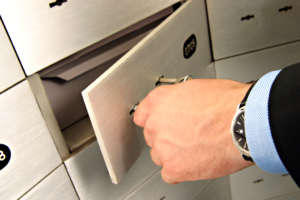Is Your Safe Deposit Box Accessible Upon Your Death?
Harry Williamson planned well for his death. After consulting with his attorney, he prepared and executed a comprehensive estate plan, including a Last Will and Testament, a Living Trust, an Advance Healthcare Directive, a HIPAA release, and powers of attorney for healthcare and finances.

So when he died, family members expected everything to proceed smoothly. Instead they got chaos. It seemed no one could find his estate planning documents. Everyone knew he had a will, he had certainly talked about it often enough, but no one knew where it was. And they needed that will to determine Harry’s wishes concerning his funeral and burial.
His three daughters tore apart his house, looking for some clue as to where his will could be. They had all but given up until his eldest daughter, Elizabeth, found a singular key in a slipper tucked under his bed. The key bore the name of the bank and a number.
Elizabeth brought the key to the bank and was told it would open a safety deposit box. However, Elizabeth would be required to provide proof of Harry’s death, as well as suitable identification, before she could use the key to open the box. In addition, Elizabeth was told she would not be permitted to remove anything from the box. However, the bank would gladly copy his will or trust documents, for a fee.
Under California law, a financial institution that holds a safe deposit box in the name of a deceased person, or deceased persons, may open the box for a third party if they possess a key and provide adequate identification and proof of their relationship to the decedent as well as a certified copy of the decedent’s death certificate.
The financial institution is required to:
- Keep a record of the identity of the person accessing the safe deposit box.
- Allow the authorized person to open the safe deposit box under the supervision of an officer or employee of the financial institution, and to conduct an inventory of the contents.
- Photocopy all wills and trust instruments removed from the safe deposit box, and keep the photocopy in the safe deposit box until the contents of the box are removed by the personal representative of the estate or other legally authorized person. The financial institution may charge a reasonable fee for photocopying.
- Permit the person given access to the box to remove the instructions for the disposition of the decedent’s remains, and, after a photocopy is made, to remove the will and trust documents.
Anyone given access to a decedent’s safe deposit box is required to deliver all wills found in the safe deposit box to the clerk of the superior court, and mail or deliver a copy to the person named in the will as executor or beneficiary. However, the contents of the box may not be removed until letters testamentary have been issued by the probate court. This means the family has to open a probate even if the decedent created a trust in order to avoid probate!
What could Harry have done differently? First, make it easy for his family to find the key. Also, either have one of his children listed as a signer or authorized user on the safe deposit box or arrange with the bank for the safe deposit box to be owned by his trust.





